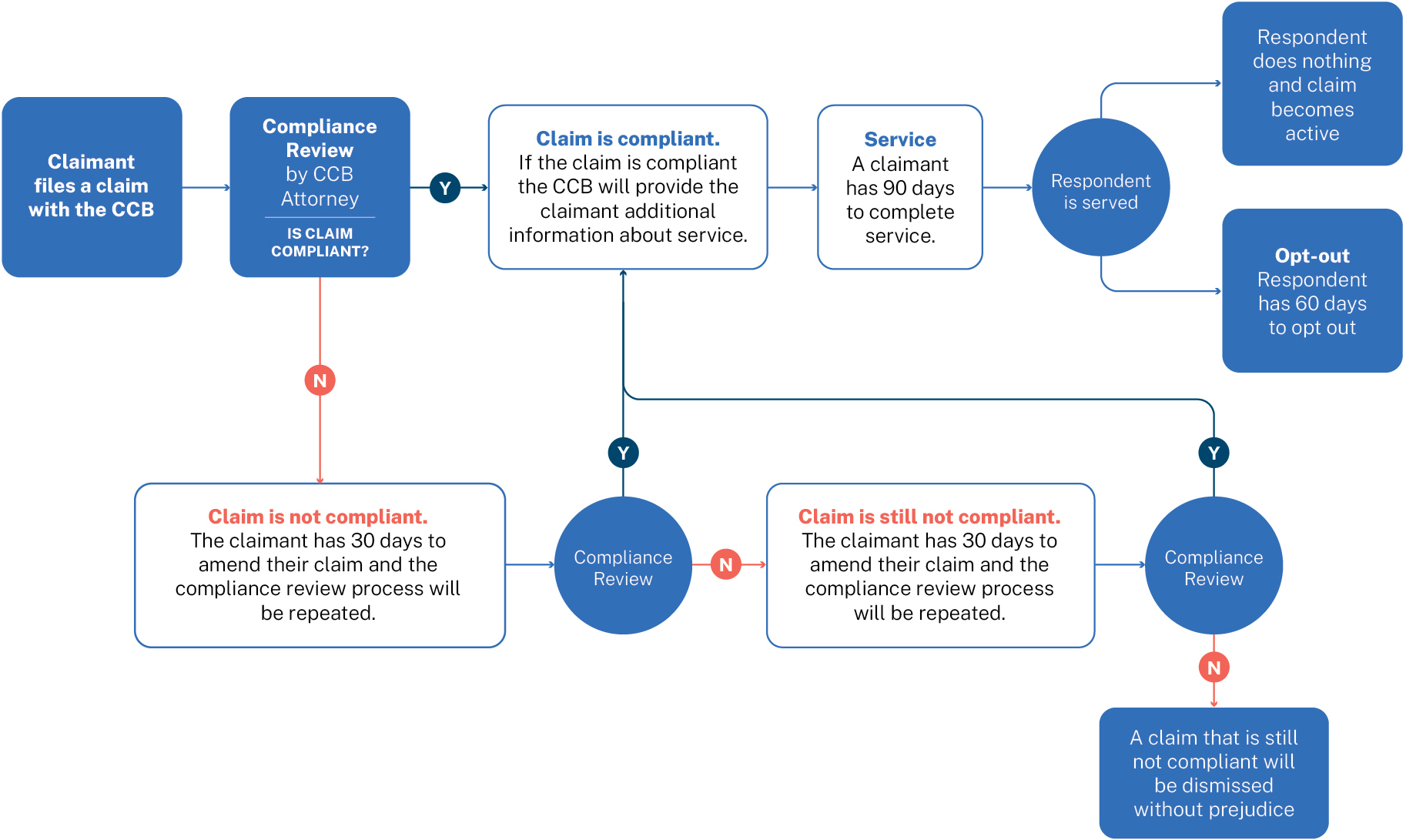Claimant Information
Welcome to the Copyright Claims Board (CCB). You can file a claim through eCCB (the CCB’s electronic filing and case management system). Learn more below about the types of claims that you can file, the outcomes that may be available, how to let someone know you have a claim against them, and the next steps to take to pursue the claim.
Information You Will Need Before You File Your Claim
To file a claim with the CCB, you will be asked to identify the work involved in the dispute, the type of claim you wish to file, and the remedies (monetary damages, an agreement to stop the infringing activities, and/or attorneys’ fees) you will be seeking.
When you’re before the CCB, the person making a claim is called a “claimant” and the person responding to the claim is called a “respondent”. When a respondent also makes its own claim against the original claimant, the respondent may be called a “counterclaimant”.
Types of Works
First, you will need to determine the copyright category of the work of authorship involved in your dispute. These categories include:
- Literary, musical, and dramatic works
- Examples include fiction or nonfiction stories, poems, textbooks, and computer programs.
- Sound recordings and musical works (including any accompanying words)
- Examples include recorded songs, spoken words, or instrumentals and notations on sheet music. The handout Musical Works, Sound Recordings & Copyright explains the difference between a musical work and a sound recording.
- Pictorial, graphic, and sculptural works
- Examples include photographs, paintings, drawings, sculptures, jewelry, maps, charts, and models.
- Motion pictures and other audiovisual works
- Examples include movies, television shows, videogames, webinars, and television or computer advertisements.
- Dramatic works
- Examples include plays, musicals, and operas.
- Pantomimes and choreographic works
- Examples include a related series of dance movements, but not a single dance move, social dance steps (such as ballroom dances, folk dances, line dances) or simple routines.
- Architectural works
- Examples include includes building design, but not individual standard building features.
Please note that copyright protects only original works of authorship. This protection does not extend to any idea, concept, system, or process embodied in a work, as opposed to the expression used to describe them. Copyright also does not protect names, titles, short phrases, or slogans.
For more information on the subject matter that copyright protects, see “Copyright Basics.”
For more information on what copyright does not protect, see “Works Not Protected by Copyright.”
- Registration. Before the CCB makes a determination in any infringement dispute, the work at issue must be registered by the Copyright Office. In order to file a claim or counterclaim for infringement, you will need to show that you have already applied for registration. You must either:
- (1) provide your work’s Copyright Office registration number; or
- (2) have submitted a registration application (a completed application, a deposit, and the required registration fee) to the Copyright Office and provide the application’s service request number (SR number).
- Expedited registration. After a CCB proceeding becomes “active,” a claimant or counterclaimant who has a pending copyright application may have it reviewed more quickly by requesting expedited registration from the CCB and paying a fee. For more information on when a proceeding becomes active, see the Phases of CCB Proceedings.
- Need to register your work? To learn more about what works can be registered with the U.S. Copyright Office, visit the Office’s registration page.
Identifying the Type of Claim
The CCB is able to hear three types of copyright disputes:
- Copyright infringement claims. Copyright infringement occurs when a copyrighted work is reproduced, distributed, publicly performed or displayed, or made into a derivative work (such as a translation of a book or its adaptation into a movie) without the permission of the copyright owner, if the use does not qualify for an exception, such as fair use.
- Claims seeking a declaration of noninfringement. A party accused of infringement (who has received for example, ”cease and desist letter”) can file a claim seeking a ruling from the CCB that its actions do not infringe copyright. This could be useful if a party is worried about continuing a project under the threat of litigation and wants clarity about the validity of the copyright owner’s rights or the application of an exception.
- Claims regarding misrepresentations when filing a “takedown” notice or a counter-notice under the DMCA. The Digital Millennium Copyright Act (DMCA) establishes a “notice and takedown” system for removing infringing content from the internet. Under this system, a copyright owner can send a “takedown” notice to an online service provider (such as a content-sharing website) describing material that someone has posted through the online service without the copyright owner’s permission. To avoid potential liability, online service providers follow specified procedures when they receive these notices, as well as when they receive counter-notices seeking the re-posting of the allegedly infringing material. The DMCA also provides that senders of either a notice or a counter-notice may be liable for damages if they knowingly make misrepresentations. Visit the section 512 page for additional information about the law and the “notice-and-takedown” procedure.
Determining What Relief to Request
Monetary relief. The CCB can only award up to $30,000 in total damages in any one proceeding, no matter how many claims or copyrightable works are at issue. The claimant may choose to seek either (1) actual damages and the respondent’s profits from the infringement, or (2) statutory damages within a set range, although this decision does not have to be made at the time of filing the claim.
- Actual damages and profits. Actual damages are money damages awarded based on the proven harm or loss suffered by a claimant or counterclaimant. An example of actual damages may be the amount of lost sales revenue experienced by the claimant. An award can also include any profits the respondent made from the infringement. The amount awarded by the CCB for both actual damages and profits will depend on the evidence, but can total no more than $30,000 per proceeding.
- Statutory damages. Statutory damages are money damages awarded to a successful claimant within a set range to compensate for infringement, without the need to provide proof of the actual amount of harm or loss. The upper and lower limits of the monetary damages are set by the Copyright Act. Statutory damages are not necessarily higher than actual damages, but are useful in circumstances where wrongdoing has been determined but the amount of actual damages or profits is hard to prove.
- In a CCB proceeding, the amount of statutory damages cannot exceed $15,000 for each work infringed. Because the overall cap on CCB awards is still $30,000, however, you will not be able to recover more than that amount no matter how many works are involved in the proceeding. The caps for statutory damages will be lower if you do not register the work(s) within the timeframe established in section 412 of the Copyright Act: $7,500 per work and $15,000 per proceeding. These are all upper limits; a successful claimant will not always be awarded these full amounts. And unlike in federal court, the infringer’s knowledge or intent is not considered in determining the amount.
- Agreement to stop infringing activities. The CCB cannot issue orders (called “injunctions” in federal court) requiring an infringer to stop engaging in wrongful activities. It can, however, include in its determination a requirement that a party stop or modify certain activities if that party has agreed to do so.
- A party might make such an agreement without admitting wrongdoing at some point during the proceedings before the CCB has made a final determination. Then, if it is found liable, the CCB may take the agreement into account to assess a lower level of damages. Please note, such an agreement will not impact the CCB’s final determination about whether the activity is infringing, so an accused party need not worry about hurting its defense.
- Attorneys’ fees. Ordinarily, a successful claimant or respondent will not be reimbursed for the costs of participating in the proceeding or of hiring an attorney to represent it. However, if a party operates in bad faith, acting in a dishonest, intentionally misleading or abusive way, the CCB may order it to pay the other party’s reasonable costs and attorneys’ fees. The cap on such awards will be $5,000, but with a lower amount of $2,500 for parties not represented by an attorney. The CCB has the ability to award a higher amount in extraordinary circumstances, where a party has demonstrated a pattern or practice of bad-faith conduct.
The next question is who the parties will be. You will need to identify the respondents, and decide if you want to represent yourself or use an attorney. You may be able to get free representation from a law student or volunteer organization.
Identifying a respondent. When filing a claim, you must identify the individuals or entities against whom you are making the claim and alert them that you are asking the CCB to hear your dispute. These individuals or entities are called “respondents.”
If one of the respondents is a business entity, such as a corporation, a partnership, or an association, it may have a “designated service agent” to receive notices of CCB claims. If it does, you must deliver or “serve” those notices on that agent after your claim has passed the CCB’s compliance review.
- Libraries and archives. A library or archives is entitled to to opt out of all CCB proceedings by filing a notice with the CCB. If you are filing a claim against a library or archives or one of its employees based on actions they took as part of their job, you should check the list of such notices before filing a CCB claim. If the library or archives is on that list, you will not be able to file that claim with the CCB.
Attorneys and law student representation. You do not need an attorney to file or respond to a claim with the CCB. CCB proceedings have been designed to be clearly understood and usable by parties who have no legal training. However, parties are allowed to be represented by or consult with an attorney. You may also wish to engage a law student at an approved legal clinic as an alternative; for more information please see our help page.
Timing
You will need to file your claim with the CCB within the time limit set by the Copyright Act. As in federal court, a “statute of limitations” sets a time limit within which the party bringing a dispute has to begin legal proceedings. The statute of limitations for claims involving copyright infringement, declarations of noninfringement, or DMCA misrepresentation is three years from the time of the activities involved in the claim.
This time period is paused once a claim is filed. If your claim ultimately doesn’t move forward with the CCB (such as if the respondent opts out or your claim doesn’t meet the CCB’s requirements), the time you spent in the CCB won’t count toward the three-year limit for filing the same claim in federal court.
Steps to Filing a Claim

I Have Filed My Claim. What Happens Next?
What to expect. After you file your claim, it will be reviewed by a CCB staff attorney to ensure that it gives enough information to the respondent and complies with applicable law and regulations. The CCB will determine if the claim is “compliant,” meaning it can move forward, or “noncompliant.” A claim might be noncompliant if, for example, it is based on infringement of a trademark or patent, or if required information is missing.
If your claim is compliant, the CCB will notify you and provide instructions on how to proceed with sending the claim to the other party or parties in order to formally notify (or “serve”) them. You should not take this as an indication of how the CCB will ultimately rule on that claim.
If even after the amendments your claim is still noncompliant, the CCB will notify you again of the reasons. If you are asked to file a second amended claim, it will be reviewed one more time, resulting in the CCB either approving it for service or dismissing it. If your claim is dismissed at this stage, you can still choose to file in federal court. Depending on the reasons for the dismissal, you may want to consult with an attorney to see whether this is a good option.
Unsuitable and ineligible claims. The CCB will be able to refuse to hear any claim or counterclaim if:
- The claim has already been decided by, or is pending before, a federal court, unless that federal court has granted a stay to permit the claim to proceed before the CCB;
- The claim is by or against a federal or state governmental entity;
- The claim is asserted against a person or entity residing outside of the United States unless the nonresident party initiated the proceeding; or
- The claim is unsuitable for determination by the CCB. Reasons for unsuitability could include resource limitations of the CCB or complex factual questions requiring extensive discovery or investigation.
The CCB will communicate with you through eCCB, the CCB’s electronic filing and case management system. Any time the CCB issues an update or order or a party files a document in your proceeding, the eCCB system will email you a confirmation with a link to the update, order, or document.
To learn more about filing through eCCB, please visit Start a Claim.
Service. “Service” is the formal delivery of documents to the other party or parties in the proceeding (called “respondents”) to provide notice of your claim. Once you have been notified that the claim has passed compliance review, you will have ninety days to serve the claim and other documents provided by the CCB on the respondents.
Serving individuals. How service is accomplished will depend on who the respondent is and where they are located. Individuals may be served personally (by hand delivery) or by mail. The rules governing the specifics of service can vary from state to state.
Additional information about service is available in the CCB Handbook to assist claimants in determining what service requirements may apply in their own proceeding.
Serving business entities. Business entities, such as corporations, partnerships, and unincorporated associations, may need to be served through a designated service agent—an individual who receives legal and other documents on their behalf.
- Designated service agent database. The CCB maintains a public directory of service agents for business entities. If you are filing a claim against a corporation, a partnership, or an association, you should check the directory to see if the business has designated such an agent to receive notices of CCB claims. Please note that the CCB directory is different from the designated agent directory for the Digital Millennium Copyright Act (DMCA).
For business entities with a designated service agent, you may serve the agent (1) by mail, or (2) by email if the directory indicates that the business entity has agreed to accept service by email. The directory will provide the address and, if applicable, the email address of the agent.
If the business entity does not have a designated service agent, it may be served personally (by hand delivery) or by mail. The rules governing the specifics of service can vary from state to state.
Waiver of service. You may also ask a respondent to “waive service” by using a form provided by the CCB. This means that they agreed to receive the claim without having been served according to the formal rules. It does not mean that they have waived their right to opt out of the proceeding. A respondent may choose to waive service because doing so gives an extra thirty days to respond to a claim after the proceeding has become active. The CCB will provide instructions and forms to use to request a waiver of service.

